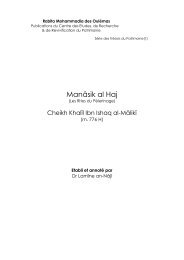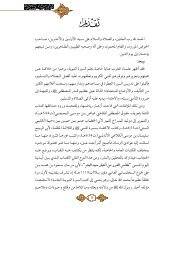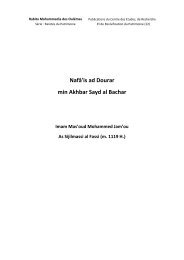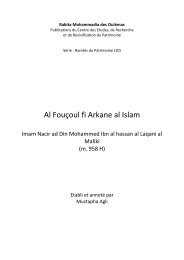Ahmad Ibn Mohammed Ibn Naçir ad Dar'î (m. 1129 h.) Cheikh soufi ...
Ahmad Ibn Mohammed Ibn Naçir ad Dar'î (m. 1129 h.) Cheikh soufi ...
Ahmad Ibn Mohammed Ibn Naçir ad Dar'î (m. 1129 h.) Cheikh soufi ...
You also want an ePaper? Increase the reach of your titles
YUMPU automatically turns print PDFs into web optimized ePapers that Google loves.
Rabita Mohamm<strong>ad</strong>ia des Oulémas<br />
Publications du Centre des Etudes, de Recherche<br />
& de Revivification du Patrimoine<br />
Série : Eminents savants de l’Occident musulman (7)<br />
<strong>Ahm<strong>ad</strong></strong> <strong>Ibn</strong> <strong>Mohammed</strong> <strong>Ibn</strong> <strong>Naçir</strong> <strong>ad</strong> Dar’î<br />
(m. <strong>1129</strong> h.) <strong>Cheikh</strong> <strong>soufi</strong> rénovateur<br />
Dr. <strong>Ahm<strong>ad</strong></strong> Amalik
<strong>Ahm<strong>ad</strong></strong> <strong>Ibn</strong> Muhamm<strong>ad</strong> <strong>Ibn</strong> Nasir <strong>ad</strong> Dar’î<br />
(d. <strong>1129</strong> h.) Sufi Sheikh Reformer<br />
When we talk about famous Morocco’s knowledge<br />
centers, we have to mention the Nâsiriya Zawiya, at<br />
Tamgourt, in the Draâ region. This Zawiya is a<br />
knowledge beacon since the eleventh hegira century<br />
due to the efforts of the Nâsiriya family which<br />
founded it and therefore contributed to the<br />
edification of knowledge and renovation.<br />
This Zawiya is historically linked to the name of a<br />
great scholar, the Sheikh, the ‘Allama, <strong>Ahm<strong>ad</strong></strong> <strong>Ibn</strong><br />
Muhamm<strong>ad</strong> <strong>Ibn</strong> Nâsir <strong>ad</strong> Dar’î, nicknamed al Khalîfa<br />
(the Calife) who died in <strong>1129</strong> hegira and deserved<br />
credit, after his father, for consolidating the<br />
foundation of the Zawiya, for diffusing its principles<br />
and teachings. This honorable Sheikh was born in<br />
1057 hegira; his education began by the teaching of<br />
Quran by his father, Sheikh Muhamm<strong>ad</strong> <strong>Ibn</strong> Nâsir <strong>ad</strong><br />
Dar’î who taught him various disciplines, as [Quran]<br />
exegisis, H<strong>ad</strong>ith, Arabic, [Fiqh] principles science, and<br />
others.<br />
The knowledge environment where he was born,<br />
as well as the four pilgrimage travels he did in the<br />
East, contributed to the polishing of his personality<br />
and to his eclectic education. This raised his position<br />
and his notoriety was diffused everywhere; the elite<br />
and the common liked him. His hundreds of <strong>ad</strong>epts
and disciples were more and more numerous and he<br />
deserved credit to raise the various branches of the<br />
knowledge movement in the Draâ region.<br />
One of the disciplines he excelled in was Sufism,<br />
and he was one of the pillars of the Nâsiririya Zawiya,<br />
initiator of its awr<strong>ad</strong> (litanies) and prayers. He was<br />
also a proponent of [prophetic] sunna and of the<br />
struggle against blameworthy innovation and the<br />
corrupt customs which were diffused in his epoch.<br />
With a view to make the route of this unique<br />
scholar and his contribution to knowledge and<br />
education more known, the Muhamm<strong>ad</strong>an League of<br />
Scholars’ Centre for Studies, Researches and<br />
Patrimony Revival publishes this book within its<br />
Eminent Scholars of the Muslim West Series. The<br />
book, composed by the historiographer Dr. <strong>Ahm<strong>ad</strong></strong><br />
Amalik, tells Sheikh <strong>Ahm<strong>ad</strong></strong> <strong>Ibn</strong> Nasir’s life, his travels<br />
and peregrinations, stressing his influence in the<br />
education and thought domains, within and outside<br />
Morocco. The high knowledge of the author of the<br />
Draâ region and its cultural, political and sociological<br />
history, <strong>ad</strong>ds to the importance of the book.<br />
Translation: Mekaoui Abdélilah
<strong>Ahm<strong>ad</strong></strong> <strong>Ibn</strong> <strong>Mohammed</strong> <strong>Ibn</strong> <strong>Naçir</strong> <strong>ad</strong> Dar’î<br />
(m. <strong>1129</strong> h.) <strong>Cheikh</strong> <strong>soufi</strong> rénovateur<br />
Lorsque l’on parle des centres d’érudition célèbres<br />
du Maroc, il faut mentionner la Zaouia Nâçiriya de<br />
Tamgourt, dans la région de Draâ, qui est l’un des<br />
phares de la connaissance depuis le onzième siècle<br />
de l’hégire, grâce aux efforts de la famille an Nâciri,<br />
qui l’a fondée et a ainsi contribué à l’édification de la<br />
science et de la rénovation.<br />
Cette Zaouia est historiquement liée au nom d’un<br />
grand savant, le <strong>Cheikh</strong>, le ‘Allama, <strong>Ahm<strong>ad</strong></strong> <strong>Ibn</strong><br />
<strong>Mohammed</strong> <strong>Ibn</strong> Nâcir <strong>ad</strong> Dar’î, surnommé al Khalîfa<br />
(le Calife), mort en <strong>1129</strong> de l’hégire et qui eut le<br />
mérite, après son père, de consolider l’assise de cette<br />
Zaouia, de diffuser ses principes et ses<br />
enseignements. Ce vénérable <strong>Cheikh</strong>, né en 1057 de<br />
l’hégire, a commencé sa formation par<br />
l’apprentissage du Coran, par son père, <strong>Cheikh</strong><br />
<strong>Mohammed</strong> <strong>Ibn</strong> Nâcir <strong>ad</strong> Dar’î, qui lui enseigna<br />
diverses disciplines, comme l’exégèse [coranique], le<br />
H<strong>ad</strong>ith, l’arabe, la science des principes [du Fiqh], et<br />
autres.<br />
L’environnement érudit dans lequel il est né, ainsi<br />
que les quatre voyages qu’il fit en Orient, à l’occasion<br />
de pèlerinages, participèrent au polissage de sa<br />
personnalité et à sa formation éclectique. Sa position<br />
en fut élevée, et sa notoriété se répandit partout ; il
fut ainsi aimé de l’élite et du commun. Ses <strong>ad</strong>eptes et<br />
ses disciples, de plus en plus nombreux, se<br />
comptaient par centaines et il eut le mérite de<br />
promouvoir le mouvement de l’érudition, dans ses<br />
différentes branches, dans la région du Draâ.<br />
L’une des disciplines dans lesquelles il excella fut le<br />
<strong>soufi</strong>sme, car il fut l’un des piliers de la Zaouia<br />
Nâçiriya, initiateur de ses awr<strong>ad</strong> (litanies) et prières.<br />
Il participa à la propagation de la Sounna<br />
[prophétique], à la lutte contre l’innovation blâmable<br />
et les coutumes viciées qui étaient courantes à son<br />
époque.<br />
Dans le but de faire connaitre d’avantage le<br />
parcours de ce savant sans pareil et sa contribution<br />
dans les domaines de la science et de l’éducation, le<br />
Centre d’Etudes, de Recherches et de la<br />
Revivification du Patrimoine de la Rabita<br />
Mohamm<strong>ad</strong>ia des Oulmas procéde à la publication<br />
de ce livre dans la Série des Savant Eminents de<br />
l’Occident musulman. L’ouvrage composé par<br />
l’historiographe, Dr. <strong>Ahm<strong>ad</strong></strong> Amalik, relate la vie du<br />
<strong>Cheikh</strong> <strong>Ahm<strong>ad</strong></strong> <strong>Ibn</strong> Nâçir, ses voyages et<br />
pérégrinations, faisant ressortir son influence dans le<br />
domaine de la pensée et de l’éducation, à l’intérieur<br />
et à l’extérieur du Maroc. La grande connaissance, de<br />
l’auteur, de la région du Draâ, de son histoire<br />
culturelle, politique et sociologique, ajoute à<br />
l’importance de l’ouvrage.<br />
Tr<strong>ad</strong>uction : Mekaoui Abdélilah
















